Toyota GR Supra Coupe 2022 Review
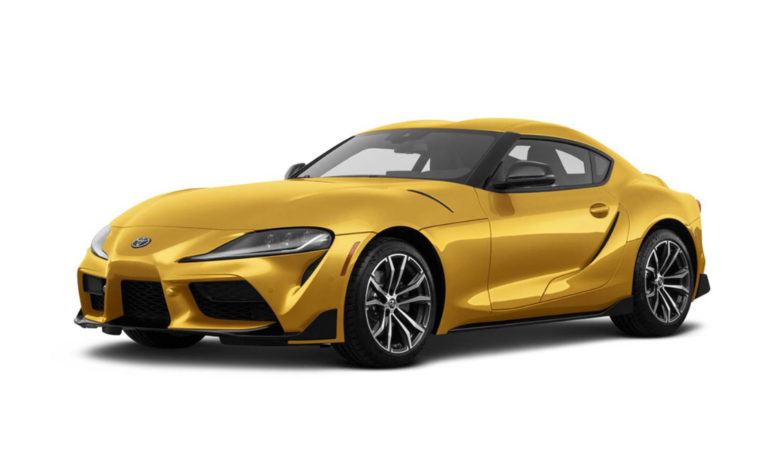
Toyota brought the Supra back for 2020 with hoopla worthy of the legendary moniker. The new Toyota GR Supra (GR stands for Toyota’s Gazoo Racing squad) continues until 2022 after adding a four-cylinder option in 2021. The Fast and the Furious, the first film in the well-liked automobile-themed movie series, featured the legendary old Supra, known for being a vicious street racer. Meanwhile, the new vehicle is contributing to creating its mythology.
The Japanese company decided to capitalize on the mystique of the Supra moniker after realizing its strength. The fifth-generation Supra was the first revised model to make an immediate impression on many admirers. The grandson of Toyota Motor Corp. founder Kiichiro Toyoda, Toyota President Akio Toyoda, is also a huge admirer. He tested a 2019 ADAC 24-hour Nürburgring enduro rally car, one of the latest GR Supras.
The modern rear-wheel-drive Supra embraces the future while incorporating the most significant elements of the past thanks to design cues from ideas like the FT-HS from 2007 and the FT-1 from 2017. It is still a short-wheelbase, two-seat coupe with two engine choices: a 2.0-litre four-cylinder engine or a 3.0-litre inline-six engine. Dynamically, it’s not terrible since the vehicle shares many of its components, including its engines, with the Z4 Roadster and other BMW models made by the German carmaker. Both cars are assembled in Austria by Magna Steyr, an engineering and supplier corporation.
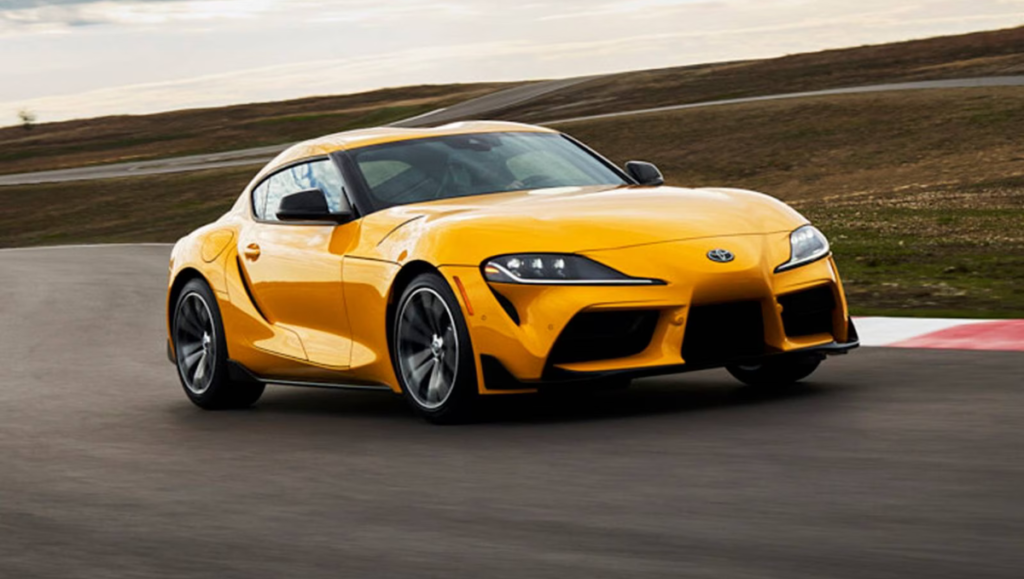
The quality and finish within the cabin are superb. It combines German accuracy with style due to collaborative development with BMW and the advantage of Toyota’s mass-production expertise. Abundant features include leather, carbon fibre accents, and well-considered details like knee cushioning to shield your limbs during sharp turns. The 8.8-inch infotainment screen on the Supra is run by software related to BMW’s iDrive system.
In its third year of resurgence, the Toyota Supra outperforms rivals such as the Porsche 718 Cayman, winning many categories. Compared to the Porsche, the well-known sports vehicle from Toyota has a smaller turning radius (34.1 vs 36.1 feet) and a larger passenger space (50.9 versus 48 cubic feet). Although the Cayman, Jaguar’s F-type, and Chevrolet’s Corvette are quicker, their prices are also much higher depending on the model.
Like the BMW, the Supra is infamous for allowing artificial engine sounds into the interior, which some fans find offensive. The real noises coming from below are nonetheless enthralling. Nothing compares to a turbo taking off and loud pops in between gears. The GR Supra is a performance sports vehicle with enough to offer drivers who are willing to pay a premium price. Toyota put a lot of effort into resolving the dispute between its brand and BMW and has succeeded in finding a good balance.
Performance: Toyota GR Supra
Under the tall, curved hood of the Supra is a monstrous engine. The 3.0-liter inline-six turbocharged engine from BMW now produces 382 horsepower, 47 horsepower higher than the unit from the previous year. The additional power is a noticeable enhancement, but it doesn’t result in an astonishingly noticeable gain in performance in practical scenarios. The acceleration time of 4.1 seconds to 60 mph was already remarkable. Toyota states that in 3.9 seconds, the 2021 Supra 3.0 can do the same. That could be too cautious.
To fill the gap between the smaller Toyota GR86 and Supra 3.0, Toyota introduced an entry-level Supra 2.0 vehicle with four engines for the 2021 model year. It has the same 8-speed automated gearbox as the 3.0-litre and a 2.0-litre turbocharged four-cylinder engine that generates 255 horsepower and 295 pound-feet of torque. It can reach 60 mph in five seconds, according to Toyota.
Crucially, the active limited-slip differential and adaptive suspension of the 3.0 are absent from the Supra 2.0. It also includes smaller front brake callipers, 18-inch wheels instead of the 3.0’s 19-inch ones, and manually adjustable seats instead of the power units seen in the six-cylinder variant.
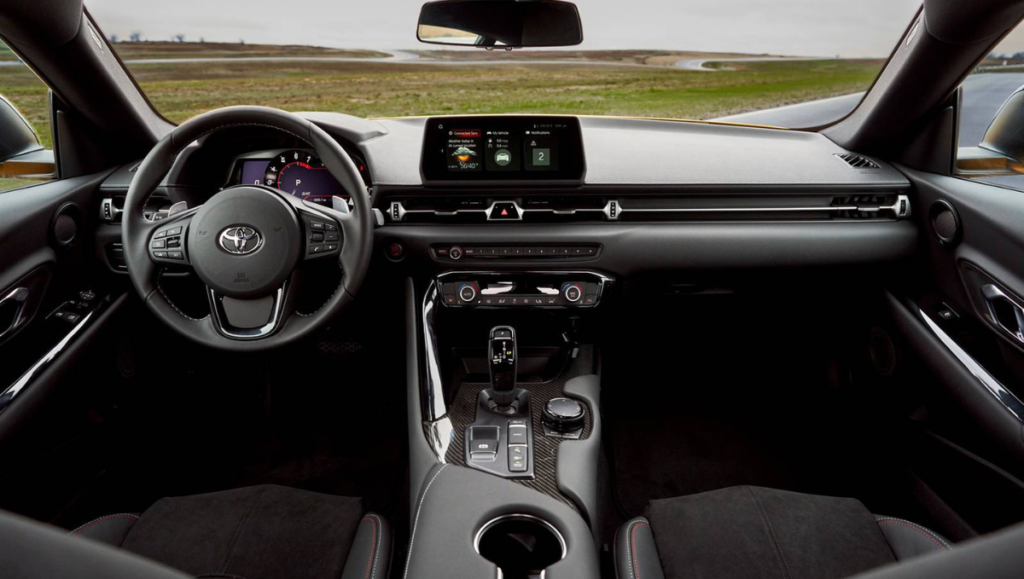
Fuel Efficiency: Toyota GR Supra
Toyota advises premium gasoline for the GR Supra. The EPA rates the 2.0-litre four-cylinder engine at 25 mpg in the city, 32 mpg on the interstate, and 28 mpg overall. The 6-cylinder model has a few drawbacks. It gets 22 mpg in the city, 30 mpg on the interstate, and 25 mpg overall.
In contrast, the 2022 BMW Z4 s30i achieves the same fuel efficiency with the same four-cylinder engine as the Supra 2.0. With the same six-cylinder engine as the GR Supra 3.0, the less aerodynamic Z4 M30i model achieves a highway rating of 29 mpg but loses one mpg. The EPA estimates that the more expensive 2022 Porsche 718 Cayman will earn 24 combined miles per gallon, while the 2021 Jaguar F-Type Coupe will get 26 combined miles per gallon.
Driver assistance and safety:
The Supra loses points in our assessment since it hasn’t been crash-tested by the National Highway Traffic Safety Administration or the Insurance Institute for Highway Safety.
That being said, Toyota’s 2.0 and 3.0 basic trims come with a new Safety and Technology Package. It has automated emergency braking, parking sensors, adaptive cruise control, blind-spot recognition, and rear-cross-traffic warning. The Driver’s Assist Package includes radar cruise control, blind-spot recognition, rear-cross-traffic warning, parking sensors, and emergency braking, and is an alternative available to 3.0 Premium and A91 purchasers.
Coziness & Space:
Although the inside may seem a little cramped, most drivers will have enough head and legroom when they fit through the narrow door opening. However, the small footprint increases agility and highlights the two-seater’s sporting nature. Sport seats with leather upholstery are standard. But you have to pretzel a bit to get into them, just as you would with any low-slung sports vehicle. The sports seats have memory controls and power when you upgrade to the 3.0 model, and the 3.0 Premium has all-black leather upholstery.
Toyota modified the Supra 3.0 chassis by installing new front and rear bump stops, stronger underhood bracing that connects the strut towers to the radiator support to enhance lateral stiffness and revised damper tuning. Similarly, new programming was given to the active differential, adaptive suspension, stability control, and electronic power steering to ensure they coordinated with the firmer chassis and produced a more pleasant ride.
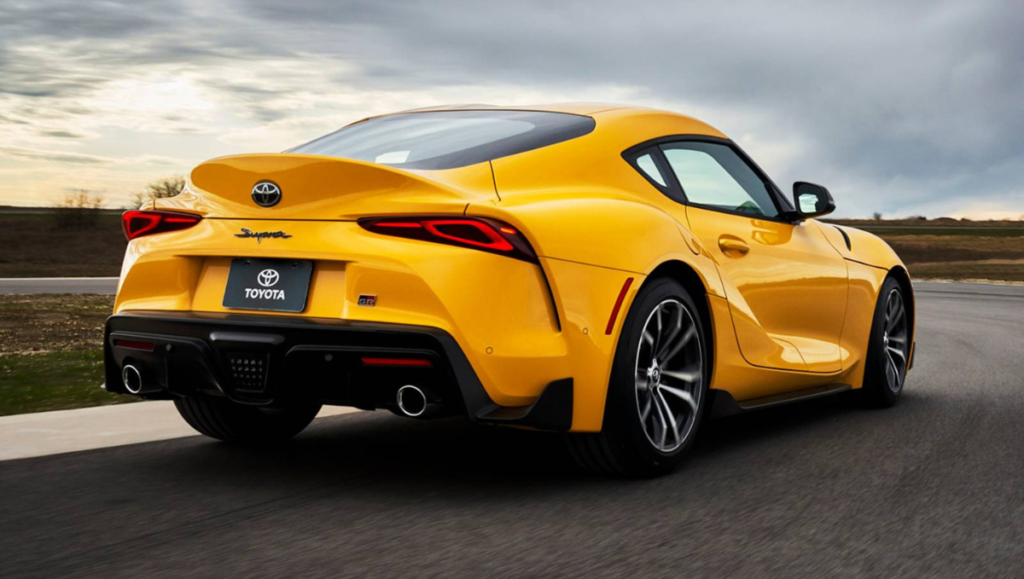
Infotainment: Toyota GR Supra
For all trim levels, the Supra comes with an 8.8-inch touchscreen infotainment system as standard. Owing to the small cabin size, the screen is accessible; nevertheless, similar to the Z4, a convenient control dial located on the centre console provides an analogue substitute. While wireless Apple CarPlay is standard, Android Auto is completely missing from this BMW since it isn’t compatible with the infotainment system.
Toyota needs to consider switching to the infotainment system that its Connected Technologies Group has created. Updated voice command capabilities complement the more giant, multifunctional touchscreen; this would be a wise addition if it integrates with Supra’s design. The Supra 3.0 is equipped with a 10-speaker sound system as standard, but the Supra 2.0 only has four speakers. There’s a 12-speaker, 500-watt JBL audio system available. This is an update you must have if you’re an audiophile.
Storage & Cargo Space:
Since the Supra is a two-seater coupe, storage is not its primary selling point. However, it provides 10.2 cubic feet of cargo space behind the hatch. That is far more than most roadsters offer and plenty for two people’s food for a week. More significant stuff can need some manoeuvring, but smaller bags can easily fit snugly to the sides of the trunk.
10.2 cubic inches is comparable to the Jaguar F-Type Coupe’s 11 cubic feet of trunk space. However, a Porsche 718 Cayman offers more excellent space for weekend travels, with 9.7 cubic feet in the rear and 5.2 more in the front. Two cupholders within the cabin support water bottles and mugs throughout the trip. Little things like a phone and a pair of keys may fit in a little console. Additionally, affordable door pockets are perfect for tiny, slender items like wallets.
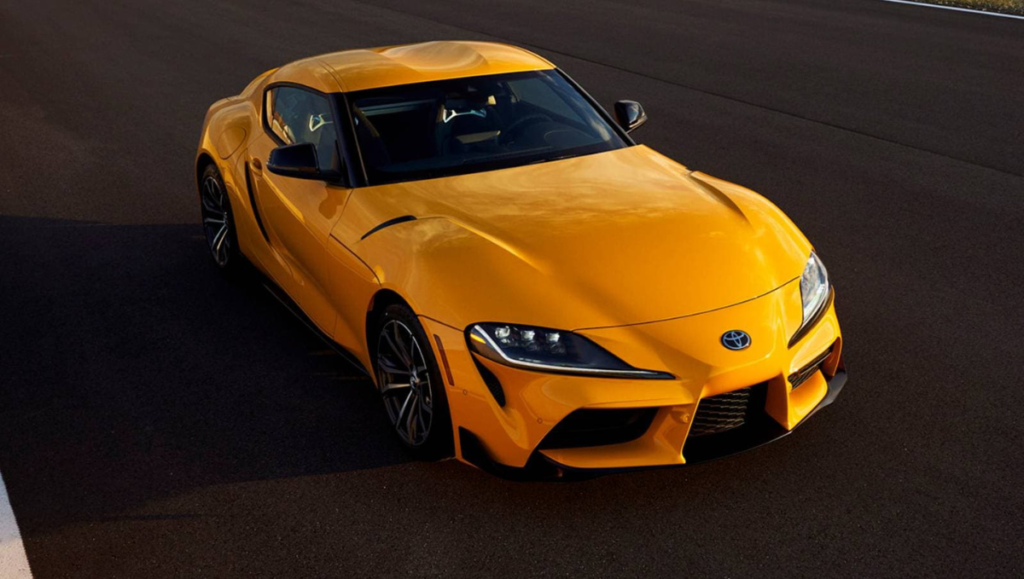
Design: Toyota GR Supra
The 2022 Toyota GR Supra is a stunning vehicle with elegant lines running down the front and soft scallops across the rear end. The legendary sports vehicle from Toyota has stood the test of time and is now even more desirable. It may compete based on appearance alone with rivals like the Porsche 718 Cayman and Jaguar F-Type, which have higher starting prices.
Reminiscent of 1960s Zagato-bodied Aston Martins, the rear is adorned with upturned tail lights and a modest ducktail, while the “double-bubble” canopy provides more headroom inside the cabin. The Supra 2.0 variant’s 18-inch cast-aluminium wheels and the 3.0 variant’s 19-inch forged alloy wheels complement the car’s overall design.
Is the 2022 Toyota Supra worth it?
The 2.0-litre Supra is the better purchase since it provides so much agility for the money. Drivers will find it so enjoyable to whip it around bends and have enough horsepower that they won’t even realize it’s not the 3.0. 2.0’s thriftiness pays dividends in two ways: Its introductory price of $44,085 (including destination taxes) is $8,000 cheaper than that of the 3.0, weighing in at 3,181 pounds, more than 200 pounds less than that of the 3.0.
The Supra 3.0 is delighted to use its power to overpower the back tires, transforming them into a cloud of smoke and two black lines on the pavement for drivers who desire more pop. Even yet, the vehicle can perform exceptionally well on winding roads when driven with a careful right foot. In sport mode, the adaptive suspension becomes much more rigid. The front and rear 19-inch wheels, measuring nine inches and ten inches, respectively, are paired with Michelin Pilot Super Sport tires that provide extreme traction on pavement.
How Much Does Toyota Supra Insurance Cost 2022?
Although the Supra is somewhat less costly than its competitors, insurance for sports vehicles is often more expensive. According to our analysis, the average yearly premium for a Supra Premium 3.0 female driver ages 30 to 40 with a spotless record is $2,476 in all 50 states. In contrast, the Chevrolet Corvette costs $2,564, the Porsche 718 Cayman costs $2,622, the similar BMW Z4 M40i costs $2,520, and the Audi TTS Quattro costs $3,056. Interestingly, however, none of them are direct rivals.
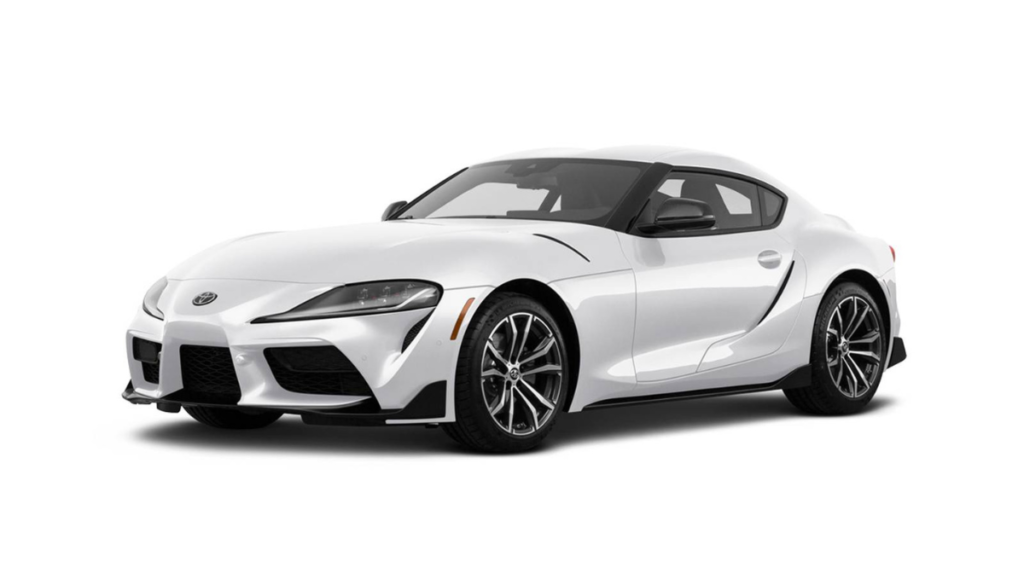
Toyota GR Supra Generations
Fifth Generation
2020 to Present
After an almost two-decade break, the fifth-generation Supra returned for the 2020 model year. It was equipped with a 3.0-liter turbocharged engine that produced 335 horsepower and was mated to an eight-speed automated gearbox. The basis and foundations are the same as those of the BMW Z4. However, Toyota is the only stylist.
Fourth Generation
1993 to 1998
The aerodynamic style of the fourth-generation Supra, which debuted in 1960, was influenced by the unique Toyota 2000GT. It was lighter than the previous model and came with a powerful 320-horsepower twin-turbo inline six-cylinder engine, while a 220-horsepower non-turbo variant was also offered. The 2ZJ six-cylinder engine of the Supra was rapidly warmed up and, in some instances, modified to produce over 1,000 horsepower by aftermarket tuners, who made it their favourite vehicle. This kind of vehicle was the model for the Supra that starred in the first Fast and Furious film. In approximately 2015, the car went up for sale, bringing about $185,000. Toyota discontinued bringing the Supra into the United States in 1998, although it was still available in other countries until 2002.
Third Generation
1986 to 1992
The first Supra to be sold as a stand-alone nameplate was the third generation. It had two versions of its substantially larger 3.0-liter inline-six engine: a normally aspirated version with 200 horsepower and a turbocharged one with 230 horsepower. The Supra’s design was completely different from the Celica’s for the first time, and compared to the front-wheel-drive Celica coupes of the late 1980s, it had a considerably sleeker 2+2 appearance. It weighed more than earlier iterations, suggesting that this was an opulent, cutting-edge GT rather than a pure sports vehicle. The final generation to use pop-up headlights was that one.
Second Generation
1982 to 1985
Although it continued to be marketed under the Celica name, the second-generation Supra began to take on a unique appearance thanks to its more angular front end and pop-up headlights. Its unique independent rear suspension was another feature. A brand-new 2.8-litre inline six-cylinder engine with 145 horsepower made its premiere. Two mechanically similar trim levels were available: the luxurious L-type and the high-performance P-type.
First Generation
1979 to 1981
The second generation of Toyota’s now-defunct Celica small sports car included the first-generation Supra. Initially, it had a larger 2.6-litre inline six-cylinder engine and was a more extended wheelbase version of that vehicle. A four-speed automatic or five-speed manual gearbox with 110 horsepower was mated to the big six. Although the 1980 model year saw the introduction of a bigger 2.8-litre engine that produced 117 horsepower, the original “Celica Supra” was more of a luxury coupe than a performance one.
Verdict
The Toyota Supra returned in 2020 after a nearly two-decade break, remaining primarily unaltered until 2022. The 2022 GR Supra comes with two engine options: a 3.0-litre turbocharged inline-six engine that produces 382 horsepower or a less-priced 2.0-litre turbocharged four-cylinder engine that produces 255 horsepower. Although the Supra’s design and platform are identical to those of BMW’s Z4 roadster, the Supra’s unique styling encapsulates that architecture in a coupe form. Although this latest generation extends the Supra’s appeal to a broader audience, it still retains enthusiast appeal.




